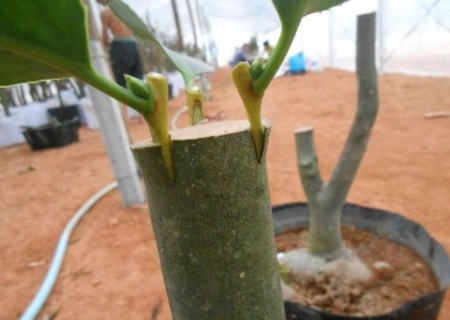Diagram of grafting technique of bonsai cleft palate
Grafting is to artificially connect the branches or buds and other tissues of one plant to the appropriate parts of the branch, stem or root of another plant, so that it can heal and grow together to form a new plant. This branch or bud is called "scion", and the plant bearing scion is called "rootstock". Grafting of flowers and trees is very skillful, especially some valuable flowers and trees, if grafted well, flowers and trees can survive smoothly and achieve the desired effect.
Grafting technology is used in bonsai. It is a leap in bonsai technology. It hangs fruits on common trees that cannot bear fruit, turns big-leaf trees with poor ornamental ability into beautiful small-leaf species, and makes residual trees with missing branches and few pieces become perfect and become whole trees. Grafting technology shortens the forming time of bonsai and changes the quality and value of bonsai.
The following is to introduce the grafting technique of bonsai-- the diagram of grafting technique of cleft palate.
1. Choose the plant varieties and rootstocks you want to graft.

In order to be successfully grafted, you must cut a scion (a small piece for grafting) from a healthy disease-free plant variety (source tree) and a suitable growth tree (rootstock). The scion should reach three dormant periods, or it is not budding. There are three to five buds on the branches about 0.3 m long. The rootstock should be straight and smooth, with vertical branches 2.5-5 cm in diameter. Cleft palate transplants should be performed before the bark of the rootstock begins to slip off in the spring (which is easy to peel off). This grafting method is usually used on a large number of branches at the top of a mature tree (to change the shape of the fruit).
2. Cut off the rootstock
Select the following point, where the branch is straight and flawless within 15 cm, and then make a clean vertical cut to remove the remaining branches. Be careful not to crack the branches and bark. Be sure to leave a nearby sprouting branch so that nutrients can flow to the tree.
3. Cut down the rootstock
Use a grafting knife or axe to cut 15 cm straight down from the center.
4. Prepare scion
Move the tip and base of the scion. Start with the buds below the bottom and cut directly to the bottom from both sides of the scion.
5. insert the scion into the rootstock
Crack the rootstock with a large screwdriver or a small chisel and insert the scion on both sides of the crack. Again, make sure that the green layer of the wood (not the bark) is aligned. The uncut side of the scion should be higher than the top of the rootstock.
6. Sealed transplantation
Pour the graft wax or asphalt emulsion into the transplanted area and seal all cut surfaces to prevent dryness and bacteria from entering. Check the seal again the next day to make sure that no holes will expose the surface.
7. Take care of the grafting site
Remove all buds that grow under the graft. Once one scion grows better than the others, prune the others that do not grow successfully. After two summers of transplantation, remove all the branches and buds except the strong scion.
Summary:
Grafting technology is an advanced technology to ensure variety and survival, and it is a superb technique from the perspective of bonsai science. Grafting for bonsai should be a kind of advanced spiritual creation, an art of applying life, and a wonderful flower of bonsai beauty!
Time: 2019-06-09 Click:
- Prev

Illustration of grafting technique of bonsai skin insertion
For bark grafting, the phloem of rootstock is easy to peel off, and the rootstock is thicker than scion. The scion should be cut longer to increase the contact surface. The advantage is that the survival rate is high, and the disadvantage is that the grafting speed is slow, and after survival, it is necessary to bind the new shoots with stents to prevent fracture. Mulberry
- Next

Edible Fungi-matters needing attention in topdressing and Identification of Edible fungus Diseases
Edible Fungi-matters needing attention in topdressing
Related
- Fuxing push coffee new agricultural production and marketing class: lack of small-scale processing plants
- Jujube rice field leisure farm deep ploughing Yilan for five years to create a space for organic food and play
- Nongyu Farm-A trial of organic papaya for brave women with advanced technology
- Four points for attention in the prevention and control of diseases and insect pests of edible fungi
- How to add nutrient solution to Edible Fungi
- Is there any good way to control edible fungus mites?
- Open Inoculation Technology of Edible Fungi
- Is there any clever way to use fertilizer for edible fungus in winter?
- What agents are used to kill the pathogens of edible fungi in the mushroom shed?
- Rapid drying of Edible Fungi

